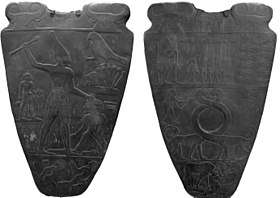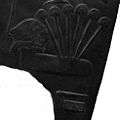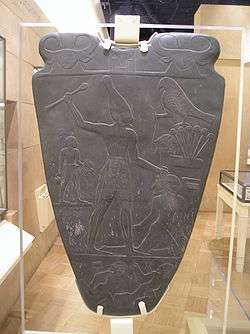Harpoon (hieroglyph)
The ancient Egyptian harpoon, (archaeological, single-barbed type), is one of the oldest language hieroglyphs from Ancient Egypt. It is used on the famous Narmer Palette, of Pharaoh Narmer from the 31st century BC, in an archaic hieroglyphic form.
| Harpoon in hieroglyphs |
|---|
Language usage of harpoon
The hieroglyphic equivalent of the harpoon is wꜥ, and means "1", a single item, and it is one of the 102 Egyptian biliterals; its use is extensive throughout the language history, and hieroglyphic tomb reliefs and story-telling of Ancient Egypt.
Rosetta Stone usage

Front side usage of harpoon-(left photo), Narmer Palette.
In the 198 BC Rosetta Stone of Ptolemy V Epiphanes, the harpoon hieroglyph is used only once, in line 8: "crowns, 10...with uraeus on their fronts, on one every among them."—("on each among them").
See also
| Wikimedia Commons has media related to Harpoon (hieroglyph). |
- Gardiner's Sign List#T. Warfare, Hunting, Butchery
- Gardiner's Sign List#U. Agriculture, Crafts, and Professions
 Closeup of archaic form on Narmer Palette
Closeup of archaic form on Narmer Palette- Example usage in text passage
 Front of Narmer Palette, using an archaic form of the Harpoon hieroglyph
Front of Narmer Palette, using an archaic form of the Harpoon hieroglyph
References
- Budge. An Egyptian Hieroglyphic Dictionary, E.A.Wallace Budge, (Dover Publications), c 1978, (c 1920), Dover edition, 1978. (In two volumes) (softcover, ISBN 0-486-23615-3)
- Budge. The Rosetta Stone, E.A.Wallace Budge, (Dover Publications), c 1929, Dover edition(unabridged), 1989. (softcover, ISBN 0-486-26163-8)
This article is issued from Wikipedia. The text is licensed under Creative Commons - Attribution - Sharealike. Additional terms may apply for the media files.